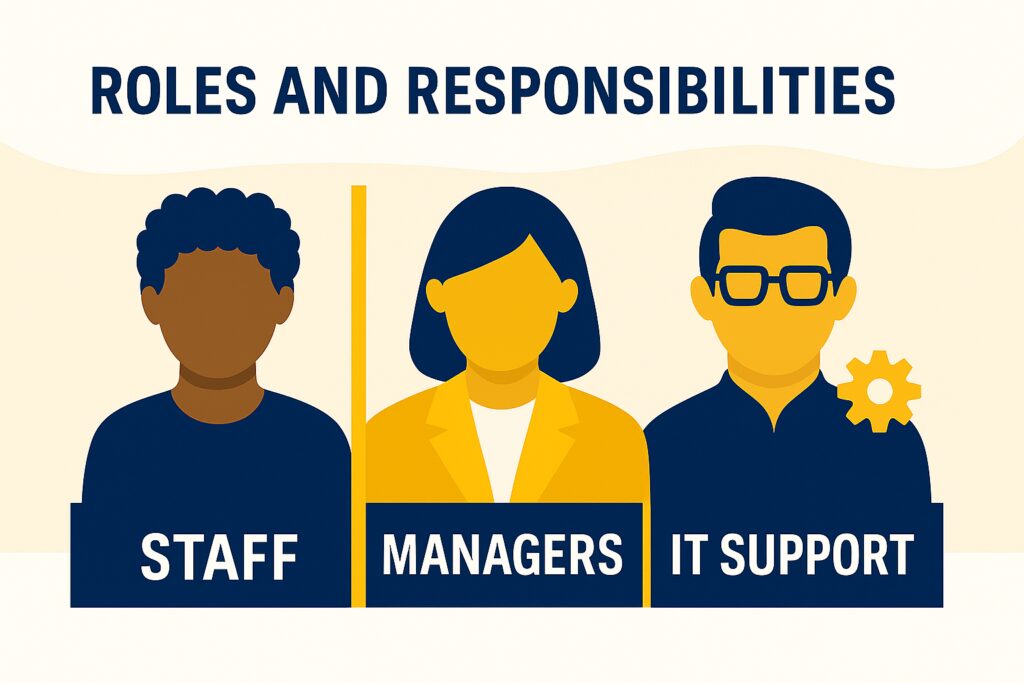OVPR Shared File Management
Organizing and Storing Files Across OVPR Units
 Managing files consistently and securely is critical to the success of the Office of the Vice President for Research (OVPR). Clear file organization ensures teams can collaborate effectively, protect sensitive data, and maintain continuity when staff roles change.
Managing files consistently and securely is critical to the success of the Office of the Vice President for Research (OVPR). Clear file organization ensures teams can collaborate effectively, protect sensitive data, and maintain continuity when staff roles change.
This guide outlines shared practices for storing, organizing, and maintaining files across OVPR units. By following these standards, we can strengthen compliance, reduce risk, and build a sustainable, accessible file system that supports the work of the entire OVPR community.
Storing Files in Shared Locations
All work-related files must be stored in shared locations where multiple staff can access and manage them.
Files saved on personal drives, local computers, or personal Dropbox or Google Drive accounts are often lost during turnover.
To ensure continuity:
- Use Google Shared Drives for active, collaborative projects.
- Use Dropbox Team Folders or OVPR Network Shares for finalized or archival files.
- Make sure at least two people always have access and administrative permissions for shared drives.
Storing files in shared locations helps prevent disruption when employees leave or change roles.
Choosing the Right Storage Location

| File Type | Recommended Storage |
|---|---|
| Collaborative, active documents | Google Shared Drive |
| Active (non-collaborative) files | Dropbox, Network Share, Canva |
| Archival or reference files | Dropbox individual folder, Network Share, AWS Glacier (fee-based) |
| Files to be deleted | Delete only with manager’s written approval |
Important:
Google Shared Drives have storage limits. Completed or inactive projects should be moved to archival storage as needed.
When in doubt, select the location that best protects file security, provides team access, and meets the file’s expected use.
Organizing Folders and Files
Organized folders and consistent naming make it easier for teams to find and manage their work.
Folder Structure Tips:
-
Group folders logically: by project, fiscal year, funding source, or department.
-
Limit folder nesting to 2–3 levels deep to avoid confusion.
-
Create a separate archive folder for completed work.
File Naming Tips:
-
Be descriptive: include project name, date, and status.
-
Use underscores (_) or hyphens (-) to separate words (avoid spaces).
-
Example:
2025_GrantApplication_ProjectName_FINAL_2025-06-01.docx
Good folder and file structures save time, reduce lost work, and make file audits much easier.
Managing the File Lifecycle
Every document should move through a clear lifecycle to keep shared storage organized and manageable:
-
Creation and Active Use
Files under active development should be saved in Google Shared Drives or equivalent collaborative locations. -
Completion
Once finalized, documents should be moved into an appropriate archival location. Update the file name to reflect that it is final if necessary. -
Annual Review
During OVPR’s summer file review process, staff should review shared storage and identify outdated or redundant files. -
Archival or Deletion
Important records should be retained according to university retention guidelines. Outdated materials should be deleted only with written manager approval.
This approach ensures files remain current, accessible, and secure.
Protecting Sensitive Information
Files must be stored based on their sensitivity level to protect personal, confidential, and regulated university data.
Best practices for protecting sensitive files:
-
Always store sensitive materials (e.g., HR documents, confidential research data) in secure, access-controlled locations.
-
Avoid keeping sensitive files on personal computers or local hard drives.
-
Use university-approved backup solutions like CrashPlan to protect local files when necessary.
If you are unsure whether your files require special handling, consult the U-M Data Classification Standards or contact [email protected].
Roles and Responsibilities

| Role | Responsibilities |
|---|---|
| Managers | Define shared storage locations for teams. Guide onboarding and offboarding. Ensure staff compliance. |
| Staff | Save work in approved shared locations. Maintain file organization. Participate in annual file reviews. |
| IT Support | Provide setup assistance, permissions guidance, and CrashPlan support as needed. |
Shared responsibility across all roles is critical to maintaining an effective file management system.
Onboarding and Offboarding
To maintain continuity when staff join or leave:
Onboarding:
-
New hires must receive an overview of unit file storage practices.
-
Supervisors should confirm that shared drive access is properly set up.
Offboarding:
-
Departing employees must transfer all work-related files to shared drives or network shares before departure.
-
Managers must verify that no important files are left in personal drives.
Reference:
U-M Employee Departure Checklist
Annual File Review Process
Each summer, OVPR units will conduct an annual review of their shared file storage:
-
Delete unnecessary working files (with written approval).
-
Archive completed or closed project materials.
-
Identify files ready for Bentley Library transfer or long-term retention.
Unit leads will provide timelines and specific instructions each year.
Annual file reviews reduce storage clutter, improve file searchability, and simplify compliance with university data retention policies.
Get Started: Complete Your Unit’s Storage Plan
Need Assistance?
If you have questions about:
-
Choosing the right storage location
-
Access or permissions
-
Backup configuration for local files
